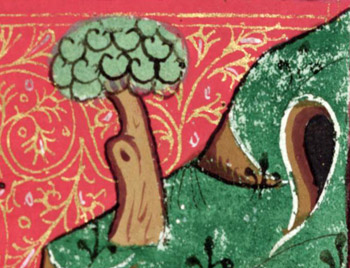Jeaste of Sir Gawain
General Information
Plot Summary

[While hunting in the forest, Gawain meets a beautiful lady in a pavilion. She warns him about her father and brothers] but he dismisses her concerns and embraces her. She succumbs to his advances, but they are soon interrupted by her father, Sir Gilbert. Furious at the loss of his daughter’s virtue, Gilbert challenges Gawain, refusing his offer of peaceful resolution. They joust and Gawain overthrows Gilbert. He spares his life on condition that he does not harm his daughter and does not challenge Gawain again. Gilbert rides off, threatening vengeance. He meets one of his sons, Sir Gyamoure, and relates the shame that Gawain has caused him. Ignoring his father’s warnings about the knight’s prowess, Gyamoure promises to avenge him.
He travels to his sister’s pavilion, where he finds her with Gawain. Rejecting his offer of peace, Gyamoure insists that they fight. Gawain unhorses his opponent but spares his life, ordering him not to challenge him again. Gyamour returns to his father and as they commiserate, Gilbert’s second son, Sir Terry, approaches. After hearing their grievances, he rides to the pavilion and confronts Gawain, again refusing his offer of amends. After Gawain has defeated him, Terry praises his prowess and warns him about the third brother, Sir Brandles, who is a great knight. Gawain spares him and he returns to his father and brother, comparing Gawain to a devil.
Sir Brandles arrives, richly armed, singing loudly and carrying a branch in his hand. Hearing what has befallen his family, he pledges to fight Gawain to the death. He rides to the pavilion, where his sister warns Gawain of his strength. Gawain’s attempts at peace are rejected for a fourth time and his pleas of exhaustion are ignored. The two knights fight until the daylight fades. Brandles suggests that they abandon the fight, but swear an oath to resume next time they meet. Gawain complies, asking Brandles to be kind to his sister. He departs on foot, abandoning his wounded horse and heavy armour. When he has gone, Brandles calls his sister a harlot and beats her violently before returning home with his father and brothers. The maiden runs away, wandering in the forest and never returning home. Gawain eventually reaches Arthur’s court, where he recounts his adventures. To the joy of the knights, he never meets Brandles again.
From: Thomas Hahn, ed. Sir Gawain: Eleven Romances and Tales. Kalamazoo, Michigan: Medieval Institute Publications, 2000.
Manuscript: Oxford, Bodleian Library, MS Douce 261
Manuscripts
Click a title below to search for all romances in that manuscript.